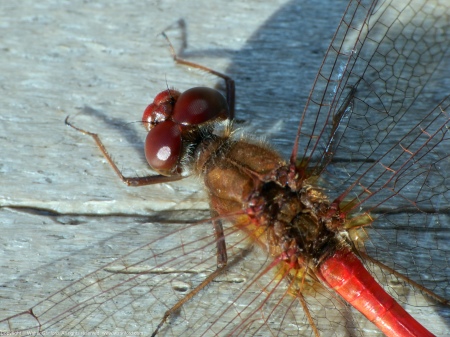I visited Huntley Meadows Park on 30 November 2014 for my first foray into macro photography. I field tested a new Raynox DCR-250 close-up filter with my Panasonic Lumix DMC-FZ150 superzoom digital camera and Canon 580EX Speedlite external flash (fitted with a Sto-Fen OM-EW Omni-Bounce, an inexpensive plastic snap-on flash diffuser). The Raynox DCR-250, like other close-up filters and extension tubes, reduces the minimum focusing distance between the lens and subject.
The following photograph of a male Autumn Meadowhawk dragonfly (Sympetrum vicinum) was taken at maximum telephoto zoom (24x) without using the Raynox close-up filter. The camera was positioned near the mininum focusing distance from the subject, in this case approximately six feet (~6′). The photo was cropped from the original size of 4,000 x 3,000 pixels (12 MP) to a pixel size of 2,690 x 2,016 (5.4 MP), in order to enlarge the subject and improve the photo composition.
The same dragonfly perched on my pant leg a while later. The next photograph was taken at ~12x zoom using the Raynox close-up filter. I estimate the “working distance” between the camera and subject was approximately three-to-six inches (~3-6″). Now that’s what I call a cooperative model! The photo is uncropped from the original size of 4,000 x 3,000 pixels (12 MP) and edited lightly.
Dragonflies have the finest vision in the insect world. The compound eyes in the largest species have as many as 30,000 simple eyes (ommatidia). Source Credit: Paulson, Dennis (2011-12-19). Dragonflies and Damselflies of the East (Princeton Field Guides) (Kindle Locations 281-282). Princeton University Press. Kindle Edition.
The next photo shows another male dragonfly perching on the boardwalk. The picture was taken at ~6x zoom using the Raynox close-up filter. The working distance was an estimated six-to-10 inches (~6-10″). The photo was cropped to a size of 3,407 x 2,555 pixels (8.7 MP) to refine the photo composition.
The last photo shows an unknown species of grasshopper. The picture was taken at ~12x zoom using the Raynox close-up filter. The working distance was an estimated three-to-six inches (~3-6″). The photo was cropped to a size of 3,593 x 2,693 pixels (9.7 MP) to refine the photo composition.
The Raynox DCR-250 close-up filter is a relatively inexpensive solution that enables my Panasonic superzoom digital camera to be used for macro photography. Set-up is quick and easy — the filter simply clips on the front of the camera lens using a universal adapter, just like a lens cap. Depth-of-field is very shallow! A cooperative subject, good light, and a lot of patience are essential for success.
Related Resources:
- Focus Stacking Tutorial for the Panasonic FZ200 and Raynox Close Up Lenses, a YouTube video by Graham Houghton
- Panasonic Lumix DMC-FZ150 “AF Macro Mode”: sample photo taken at minimum focusing distance of 1 cm (~0.4 in); not true macro.
- Three Ways to Do Macro Photography, by B&H Explora
- More Ways to Do Macro Photography, by B&H Explora
Copyright © 2014 Walter Sanford. All rights reserved.
Tags: Autumn Meadowhawk dragonfly, friendly, friendly Sympetrum spp., gear talk, grasshopper, Huntley Meadows Park, macro photography, male, Sympetrum vicinum, wildlife photography




December 4, 2014 at 5:16 am |
Fascinating results, Walter–you were able to get in really close and capture some great details in your images. I have read about the Raynox, but didn’t know anyone who had used it. I’m always interested in experimenting with new macro methods and this might be fun to try myself.
December 4, 2014 at 1:09 pm |
I own two other cameras in addition to the Panasonic, as you know Mike. Well, three if you count an old Canon PowerShot G9. Although I have sets of extension tubes for the Canon 5DM2 and Fujifilm X-T1 digital cameras, I use them rarely. I don’t like to change lenses in the field, so I’m reluctant to remove a lens in order to add extension tubes between the camera body and lens. As you also know, the Panasonic Lumix DMC-FZ150 is my “walking around” camera — it’s almost perfect for the subjects I like to shoot. Except it couldn’t do true macro, that is, until now. I think the Raynox is an ideal solution. Let’s say I’m walking around shooting telephoto shots when something small catches my attention — I just reach in my pocket, clip the DCR-250 on the lens and boom, I’m ready to shoot macro! Hard to beat for ease of use.
December 5, 2014 at 3:09 pm |
I came to your blog because a reader on my blog often talks about your work and puts it on Facebook. I am glad I did find your blog as you do wonderful photos of insects, plus you know all about them. I like macro photography, but often I am lax in knowing what insect I am photographing.
December 5, 2014 at 3:34 pm |
Welcome to my photoblog and thanks for the kind words, donna213! My overarching goal for the blog is to combine photographs, including artful photos whenever possible, with information. Once a teacher, always a teacher!
December 5, 2014 at 4:11 pm |
I do like artful photos. I just mentioned that in a comment myself. Nice you were a teacher, it explains the knowledge of subjects.
December 6, 2014 at 2:43 am |
Great photos. Wish I had a macro lense
December 6, 2014 at 9:08 am |
Thanks, Marie! The Raynox DCR-250 is one of the least expensive ways to get in the game — go for it!